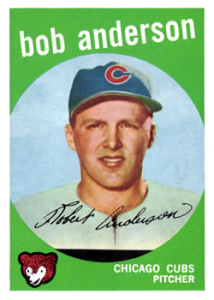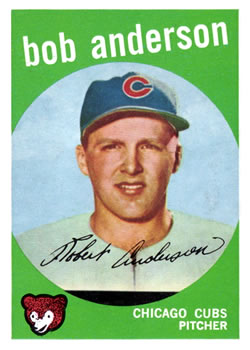June 30, 1959: Two balls in play lead to Cardinals’ protest at Wrigley Field
 The Chicago Cubs-St. Louis Cardinals rivalry has provided many memorable moments since the nineteenth century, but the circumstances could not have been more mundane when the two teams met at Wrigley Field in June 1959.
The Chicago Cubs-St. Louis Cardinals rivalry has provided many memorable moments since the nineteenth century, but the circumstances could not have been more mundane when the two teams met at Wrigley Field in June 1959.
They were in fifth and sixth place respectively amid championship droughts.1 This Tuesday afternoon game had just 9,885 in attendance. It proceeded routinely until the top of the fourth inning, when history was made – a baseball oddity for the ages.
St. Louis had scored in the first inning against Chicago starter Bob Anderson. Bill White, a preseason acquisition from the San Francisco Giants who went on to be a key member of the Cardinals’ World Series champions in 1964, doubled and came home on Ken Boyer’s single. A second Cardinals run followed in the second inning when Dick Gray singled in venerable Stan Musial, age 38 and in the 18th season of his Hall of Fame career.
The Cubs cut the deficit to 2-1 in the third, as St. Louis’s Larry Jackson walked Ernie Banks to load the bases, then walked Dale Long, sending Tony Taylor home with an unearned run.
Anderson retired Gino Cimoli for the first out in the top of the fourth and Musial came to the plate with the bases empty. With his distinguished tenure in St. Louis winding down, Musial entered the game batting .259 and hitting sixth in the order.
Out of Musial’s 10,972 major-league at-bats by the time he retired in 1963, this may have been the strangest.
Musial worked the count to 3-and-1. Anderson’s next pitch was inside and high, whizzing by catcher Sammy Taylor and traveling to the backstop. Home-plate umpire Vic Delmore, in his fourth season in the NL, signaled ball four.
Ignoring the ball, Taylor began a heated discussion with Delmore, arguing that the pitch ticked Musial’s bat. Anderson walked toward home plate to help Taylor press his case.
Musial, urged on by the Cardinals dugout, broke for second to take advantage of the lack of attention being paid to the ball. Delmore absentmindedly produced a new ball from his pouch and put it in Taylor’s glove, seemingly hoping to end their argument. Taylor flipped it to Anderson.2
In the meantime, veteran Cubs third baseman Al Dark had alertly run behind home to get the live ball – which, in the confusion, might have been touched or picked up by a batboy or longtime Wrigley Field public-address announcer Pat Pieper, who was seated in a folding chair by the first-base dugout.3 With Musial now almost to second, Dark threw from the backstop.
At the same moment, Anderson became alerted to do the same with his ball. It arrived first, sailing over Tony Taylor at second. Dark’s ball arrived, too – a one-hop to shortstop Banks on the third-base side of the second-base bag.
Musial, who while sliding saw Anderson’s throw enter the outfield, headed to third but was quickly tagged by Banks with the ball thrown by Dark. Musial – apparently not feeling Banks’ tag – continued to third, where the umpires told him he was out.
Immediately, managers and players were on the infield trying to make sense of what happened. On two occasions, the umpiring crew (Delmore, Shag Crawford, Al Barlick, and Bill Jackowski) broke away for private discussion.
Crew chief Barlick, after 20 minutes, called Musial out on the premise that he was tagged off the base by the original ball, thrown by Dark to Banks.4
The umpires ruled Musial safe at first base via base on balls. When play was about to resume, Cardinals manager Solly Hemus came out of the dugout, again, to declare that St. Louis was playing under protest. He alleged that the ball had been touched by a batboy before Dark retrieved it, and that it should have been ruled a deadball at that moment.
The protest was moot after the Cardinals scored in the seventh and eighth innings to pull away for a 4-1 win. The Cardinals stole on Taylor a total of six times, with four of the steals leading to St. Louis’s final two runs. Jackson retired 19 of the last 20 batters he faced to close out the complete-game four-hitter.
Immediate print reaction to the “two balls” play was colorful. The Chicago Tribune reported, “Baseball reached a daffiness ceiling in Wrigley Field Tuesday. … Two baseballs were thrown almost simultaneously, promoting perhaps the most hilarious moments ever witnessed in the staid north side park. Not even Bill Veeck [who had purchased the Chicago White Sox before the 1959 season] could conjure up such a zany episode.”5
The St. Louis Post-Dispatch wrote, “Baseball rules take into account the use of only one ball at a time, and so it isn’t surprising that two such activated spheres can cause no end of consternation. … [T]he tangled web of events divided most participants and observers into 57 varieties of opinions.”6
What happened to the original ball is still in question. Research indicates that no two stories are exact. Recorded descriptions include:
- Cubs batboy Bob Schoenfeldt picked it up and threw it to Pieper, but it was intercepted by Dark.
- It ended up in Pieper’s hand, and he dropped it “like a hot potato” when he realized the play was active.
- Pieper had actually put the ball in his ball bag, and a different ball was produced as the ball in play.7
- The Cardinals batboy picked it up and rolled it to Pieper.
We will never know what exactly happened to the ball after it went by Delmore and before it got in the hands of Dark. The trip the second ball took is also in question.
Dark later recalled, “When the ball got by the catcher, I took off after it. I didn’t know whether it hit the bat or not. It didn’t matter. My job was to get the ball. It rolled back to the bench where Pat Pieper used to sit. Pat picked up the ball and I yelled ‘drop it, drop it’ and he did. While this is going on, Musial is trotting down to first base and the first base coach starts waving his arms in a whirlwind. … About this time, Delmore puts a new ball in play and gives it to Taylor. He sees Musial heading for second and throws the ball to Banks.”8
The second-base umpire, Jackowski, interviewed in 1994, recalled the same story as Dark, but thought the errant ball came from Anderson, not Taylor. “The catcher said, ‘give me a ball,’ and Vic gave him one. I felt sorry for Vic. It could have happened to anyone.”9
The game was being called by Jack Quinlan on Chicago’s WGN Radio. Quinlan did an admirable job keeping up, alertly informing listeners, within 30 seconds of play-by-play, that the action involved two baseballs. “The big point is, which is the official baseball?” wondered Quinlan.10
Much of the blame was placed on Delmore. Vic “The Deacon” Delmore worked in the Kentucky-Illinois-Tennessee League and the Southern Association before being promoted to the NL in 1956. He was well-liked. At the close of the 1959 season, National League President Warren Giles – whose secretary at the league office was Delmore’s wife – dismissed the umpire. This play was assumed to be the reason.11
Despite an uproar from supporters and many letters to Giles, Giles stuck with his decision.12 On June 10, 1960, less than a year after this game, Delmore died at the age of 44.
Dark recalled, “I do remember everyone laughed at Vic Delmore. That play ruined him, and he was a great fellow and a good umpire. But he was out of the league at the end of the year and dead a year later.”13
We will never know the exact paths the balls took to create the bizarre scene, but its circumstances were unfortunate, the product of inattentive players and umpires and possible interference by nonparticipants. With the continual refinement of the game and its surveillance, it’s impossible to think something like this would happen again at baseball’s highest level. Today, it’s an anecdote reflective of how simple the game once was.
Acknowledgments
This article was fact-checked by Laura Peebles and copy-edited by Len Levin.
Sources
In addition to the sources listed in the Notes, the author consulted Baseball-Reference.com and Retrosheet.org for pertinent information, including the box score and play-by-play.
https://www.baseball-reference.com/boxes/CHN/CHN195906300.shtml
https://www.retrosheet.org/boxesetc/1959/B06300CHN1959.htm
Notes
1 The Cubs had not won a National League pennant since 1945 or a World Series since 1908; they did not win either again until 2016. The Cardinals’ most recent championship was in 1946, when they won the NL pennant and World Series; they returned to the postseason in 1964, winning the pennant and World Series.
2 Robert Morrison, “Cards Steal One from Cubs After Odd-Ball Play on Musial,” St. Louis Post-Dispatch, July 1, 1959: 4C.
3 Pieper began working for the Cubs in 1904, became the public-address announcer in 1916, and served in that capacity until 1974. He traditionally sat at the brick wall behind home plate and provided balls to umps along with traditional PA duties.
4 Edward Prell, “Musial Walks into Center of Hilarity,” Chicago Tribune, July 1, 1959: 60.
5 “Musial Walks into Center of Hilarity.”
6 Robert Morrison, “Cards Steal One from Cubs After Odd-Ball Play on Musial.”
7 Eric Chesterton, “What Happens When Two Balls Are in Play at Once?,” MLB.com, May 16, 2020, www.mlb.com/news/when-two-balls-were-in-play-at-the-same-time.
8 John C. Skipper, Take Me Out to the Cubs Game: 35 Former Ballplayers Speak of Losing at Wrigley (Jefferson, North Carolina: McFarland Press, 2000), 110.
9 John C. Skipper, Umpires: Classic Baseball Stories from the Man Who Made the Calls (Jefferson, North Carolina: McFarland Press, 1997), 110.
10 Recording of WGN Radio Broadcast of “Two Balls” Play, “6-30-1959 Cubs-Cards, ‘two balls in play,’ YouTube.com, accessed January 17, 2023, https://www.youtube.com/watch?v=p4hDjmS_FSc. Here is a transcription of the play, covering 30 seconds of airtime: “There’s a ball and it goes all the way by Taylor, ball four, and Musial’s trotting up to first base. But Taylor’s not chasing the ball, instead he’s arguing with plate umpire Vic Delmore, evidently claiming that it hit Musial’s bat. Musial now is on his way to second base, the throw down to second base sails over Tony Taylor’s head into right-center field, THERE’S ANOTHER BALL coming from around the plate somewhere, it’s taken by the shortstop Ernie Banks, Musial gets up from his slide and is going to try for third base and Banks runs him down and puts the tag on Musial. Boy, what a big rhubarb we have on the field right now!” Quinlan then paused before saying, “The big point is, which is the official baseball?” Quinlan believed the second ball was thrown by Anderson.
11 Another possible reason is mentioned at the end of Delmore’s obituary: “His friends insisted that he had been dismissed because at the end of the 1959 baseball season he had married Miss Bochmann, who was in charge of umpiring assignments in Mr. Giles’ office.” “Vic Delmore, 43, Former Umpire,” New York Times, June 11, 1960: 21.
12 “Vic Delmore, 43, Former Umpire.”
13 Skipper, Take Me Out to the Cubs Game, 110.
Additional Stats
St. Louis Cardinals 4
Chicago Cubs 1
Wrigley Field
Chicago, IL
Box Score + PBP:
Corrections? Additions?
If you can help us improve this game story, contact us.


